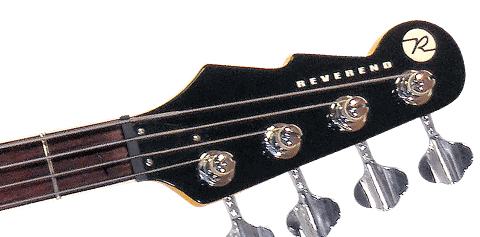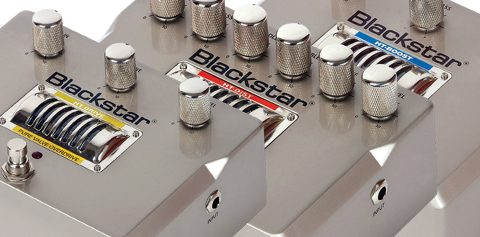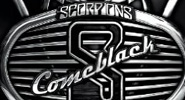
Players who love a hotrod Lincoln, a good drive-in, or a rocking retro guitar are familiar with Reverend Guitars, a brand that builds instruments that all but ooze vintage style mixed with modern amenities. And Reverend models like the Rumblefish have long been meeting the needs of session and touring bassists.
Reverend’s latest bass, the Thundergun, has the heart of a classic… or three! Its body has raised center sections (in probable homage to Gibson’s Thunderbird), while its five piece korina/walnut neck is glued to the body, its medium-oval-shaped 2″-radius neck is fat enough for players more into a Fender Precision, but fast enough for fans of the Jazz Bass, and its tilted/reverse headstock adds flair. Binding and block inlays add bling to its rosewood fingerboard.
The Thundergun is more than a hip T-bird-inspired beast. Its pickups – Reverend’s Thick Brick in the bridge and Split Brick in the neck – will have your eyes telling you to expect P-Bass-/Music Man-type tones. And its control palette, with knobs for Volume, Tone, and a pickup-pan, hint this is a serious workhorse.
Our test bass had Reverend’s Vintage Clear finish, which is one of three finish options (with Black and Cherry) and looked stellar, its amber tint accentuating the Korina body. The black pickguard and matching headstock nicely round out the overall look.
Of course, finish and construction is irrelevant if an instrument can’t deliver, sonically, and the Thundergun doesn’t disappoint. Its pickup configuration may seem odd at first, but really, it nicely fills a niche. The approach adds oomph and attack the standard P/J setup. A nice touch would have been the push/pull control Reverend normally uses with the Thick Brick. Reverend’s versions of these pickups are passive, an interesting choice. Their overall tone has a vintage warmth and depth, but with plenty of definition for more-modern styles. The Split Brick has a stronger ’70s/P-Bass vibe, partly because Korina is a brighter-sounding wood. On our test run, it worked great both live and in the studio, playing various styles and genres. The pickup-pan blend was a great choice, too, since blending in just a taste of the Thick Brick gives extra grit that worked well for picked lines, and especially overdriven parts.
The Thick Brick is a slappers delight, though that form isn’t the first thing you think about looking at the Thundergun. Being passive, it tends to not have the overwhelming high-end tonal response associated with summarily styled pickups, and is more open-sounding than some.
The Thundergun shines most brightly when it comes to sheer playability, thanks mostly to its body shape. The neck is plenty fast for solo players, yet retains the girth low-slingers love. Access is great all the way up the fingerboard, and those with advanced techniques can use the Thundergun in a variety of situations with virtually no limitations.
In all, the Thundergun plays very well, looks awesome, and sounds killer.
Reverend Thundergun
Price: $1,199
Contact: reverendguitars.com
This article originally appeared in VG September 2011 issue. All copyrights are by the author and Vintage Guitar magazine. Unauthorized replication or use is strictly prohibited.


 Eastwood Guitars’ Marksman 5 is a tribute replica of the 1957 Magnatone Mark V. It has a chambered mahogany body with sunburst finish, 24¾”-scale on a 22-fret set mahogany neck, rosewood fretboard, and measures 1 5/8” at the nut. Sound is delivered through a pair of custom EW Alnico SCP90 pickups with a three-way switch, one Volume and one Tone control, and an adjustable roller bridge. Read more at
Eastwood Guitars’ Marksman 5 is a tribute replica of the 1957 Magnatone Mark V. It has a chambered mahogany body with sunburst finish, 24¾”-scale on a 22-fret set mahogany neck, rosewood fretboard, and measures 1 5/8” at the nut. Sound is delivered through a pair of custom EW Alnico SCP90 pickups with a three-way switch, one Volume and one Tone control, and an adjustable roller bridge. Read more at  Celestion’s new G12H-75 Creamback speaker has a 50-ounce “H” (heavy) ceramic magnet, paper cone with paper edge, can handle 75 watts of output with 100dB sensitivity, and has an eight-hole chassis. See more at
Celestion’s new G12H-75 Creamback speaker has a 50-ounce “H” (heavy) ceramic magnet, paper cone with paper edge, can handle 75 watts of output with 100dB sensitivity, and has an eight-hole chassis. See more at  Jorma Kaukonen’s Fur Peace Ranch Guitar Camp has announced its 2014 schedule. Located in Southeast Ohio, the ranch will once again host workshops with Kaukonen, Jack Casady, and many others throughout the year. In 1989, Kaukonen and his wife, Vanessa, conceived “a ranch that grows guitar players” – a place where budding and seasoned musicians could immerse themselves and emerge with renewed inspiration and tangible progress in their music. See the schedule at
Jorma Kaukonen’s Fur Peace Ranch Guitar Camp has announced its 2014 schedule. Located in Southeast Ohio, the ranch will once again host workshops with Kaukonen, Jack Casady, and many others throughout the year. In 1989, Kaukonen and his wife, Vanessa, conceived “a ranch that grows guitar players” – a place where budding and seasoned musicians could immerse themselves and emerge with renewed inspiration and tangible progress in their music. See the schedule at  DiMarzio’s Illuminator and Illuminator 7 pickups were designed for Dream Theater guitarist John Petrucci’s new Music Man JP13 with ceramic magnets and outputs of 295mV (neck) and 410mV (bridge). DC resistance is 10.50 (neck) and 10.56 (bridge) K-ohm, and they are available as aftermarket upgrades. Learn more at
DiMarzio’s Illuminator and Illuminator 7 pickups were designed for Dream Theater guitarist John Petrucci’s new Music Man JP13 with ceramic magnets and outputs of 295mV (neck) and 410mV (bridge). DC resistance is 10.50 (neck) and 10.56 (bridge) K-ohm, and they are available as aftermarket upgrades. Learn more at 








